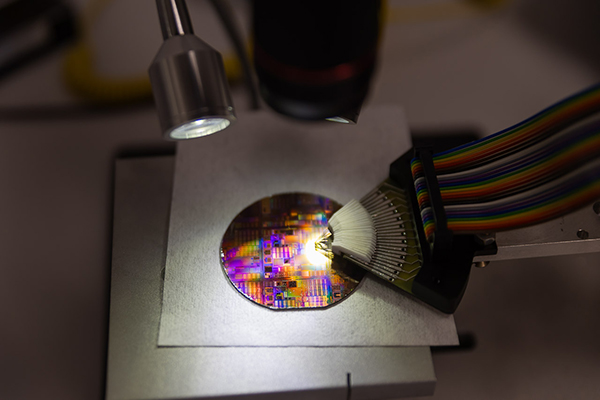(c) CEA/ Pierre Jayet
Co-funded by the French government, the AURA region and the Grenoble metropolitan area (CPER SPINfab (CNRS, CEA, UGA), Equipex Nanofutur, FEDER SPINfab, PEPR SPIN and PEPR Electronique), SPINfab is a part of the Auvergne-Rhône-Alpes region's strategic focus on innovation as a major lever for development, by complementing research infrastructures with facilities that promote collaboration with companies, in response to economic, social and environmental challenges.
Spintronics, which exploits not only the electron's electrical charge but also its spin, makes it possible to design circuits that are more energy-efficient, reconfigurable and resistant to hostile environments, making it a key technology for fields as diverse as artificial intelligence, embedded electronics, high-performance computing and connected objects.
(c) CEA/ Pierre Jayet
 The SPINfab project involves setting up a pilot production line, unique in France, for advanced spintronic materials, designed to meet the challenges of green electronics. The aim is to develop innovative magnetic materials that will drastically reduce the energy consumption of electronic systems in operation, by integrating these materials into the heart of microelectronic components.
The SPINfab project involves setting up a pilot production line, unique in France, for advanced spintronic materials, designed to meet the challenges of green electronics. The aim is to develop innovative magnetic materials that will drastically reduce the energy consumption of electronic systems in operation, by integrating these materials into the heart of microelectronic components.
To achieve this, several pieces of equipment dedicated to spintronics will complement the more standard nanofabrication equipment on the Plateforme Technologique Amont (PTA) (CEA-Irig/SPINTEC), and will be installed in an extension to this open research infrastructure and member of the national RENATECH network:
- a state-of-the-art multi-chamber cathode pulverization deposition cluster. This equipment, the only one of its kind in France, will enable the deposition of layers of complex materials, thanks to a system featuring at least twenty targets, co-evaporation, a heated sample holder and an in-situ annealing system that enables a material to be heated directly during or just after manufacture, without removing it from the device, to improve its properties.
- a plasma etching reactor specifically designed to process magnetic materials used in spintronics, with the option of in-situ encapsulation.
(c) Corrado-Carlo Maria Capriata, Jérôme Faure-Vincent, Pedro Branda Veiga, Matthieu Martin @SPINTEC 2025
Over and above the strong impact on training, by giving students, engineers and PhD students access to cutting-edge equipment, this line will enable the French spintronics community to maintain its international academic leadership and boost its capacity for innovation.
In addition, as the spintronics line is perfectly compatible with LETI's downstream industrial activities (CEA-DRT), it will be able to meet the needs of manufacturers wishing to explore demonstrators or prefigure future products, thereby strengthening France's and Europe's industrial and technological sovereignty.
In an uncertain geopolitical context, mastering advanced nanotechnologies, particularly in terms of materials, has become a strategic challenge.